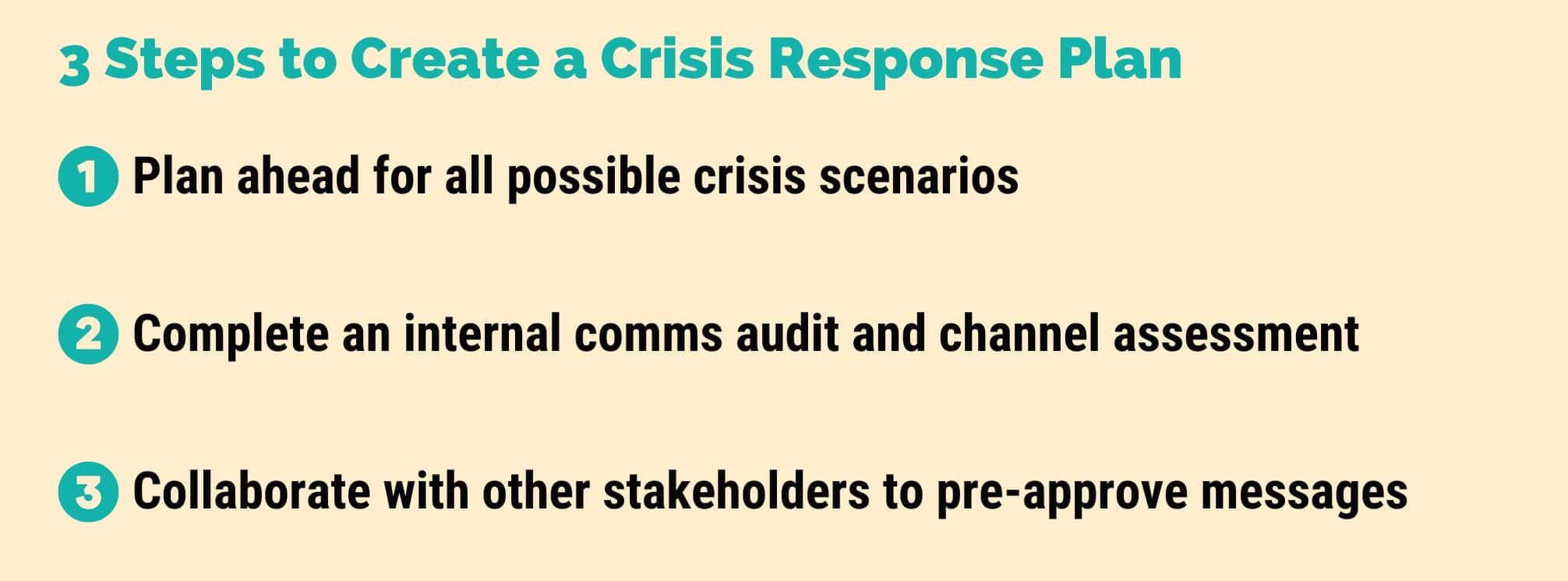
One of my favorite sayings is that you have to be proactive to successfully react in any situation. In internal communications, we often talk about this. But the reality is we’re always reacting in some way. The difference between those that seem to keep their cool and uphold their strategic vision and those of us who always feel like we’re always putting out fires is that they’ve prepared their crisis response plan ahead of time. They’ve looked at all possible scenarios and put together a communications strategy to successfully react in that moment. If you make one resolution for the year, let it be scenario planning that supports your strategic direction.
A crisis response plan (CRP) is a pre-approved strategy that an organization puts together before a crisis happens. This plan outlines the steps and actions they will take in the event of various scenarios with the goal being to mitigate damage, risk, and ongoing repercussions.

An effective CRP is going to include:
Getting your whole leadership team and department stakeholders on board with your crisis plan isn’t always easy. In so many crisis situations, everyone worries more about their external image and, therefore, the PR plan. You might have to be the one who advocates for how your internal audiences are communicated to and cared for.
Use these three tips to get that ball rolling at your company and make sure you come out with a strong internal crisis communication strategy.
Look at your goals and editorial calendar and think through at least two scenarios that could impact your ability to achieve those goals. What if that rumored merger or acquisition is officially announced? Or if there is a change to the leadership team? Think through your plan, looking for different possible scenarios that could impact your business this year, and then create internal and external comms plans for those situations.
If there’s one thing we learned from the pandemic, it’s where there are gaps in our strategies. Can you reach your frontline workforce? Do you have a means to quickly get information to your remote workforce? A channel audit will help you clearly identify where those comms gaps exist and help you prioritize solutions.
Download our Internal Comms Audit Guide for additional tips to start this process (note it includes an editable audit template).
While we like to think we have our finger on the pulse, we are sometimes kept out of the loop on critical projects. Create a regular meeting with other business partners who often come to you with comms requests or who have gone rogue in the past. Use this meeting to discuss upcoming programs, rollouts, and campaigns that will require your comms expertise. Wrapping your arms around the programs early will help you plan ahead and save yourself the scrambling to react.

The last few years have been very difficult, but let’s turn that into a motivator to be proactive in our reactions going forward.
Take this time to create the strategies and templates that will help us be more successful when the unexpected happens. And if after completing your audit you need advice on selecting the right mobile communication solution, get in touch.
Amy Jenkins is theEMPLOYEEapp’s Director of Client Strategy & Success. With over ten years of experience working in internal comms, Amy helps our clients create mobile communication strategies that get results.
[optin-monster slug=”gqorn0natkqgyrtjvr6i” followrules=”true”]
Learn how to create a great content strategy in 10 steps.
Create a comms plan that makes you a strategic advisor.
Get ahead of the next crisis with these tips.
